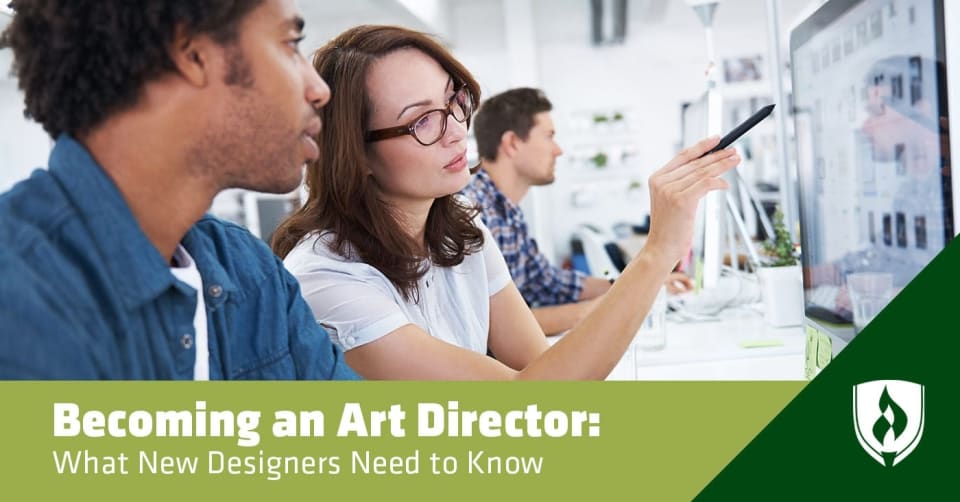
It’s not unusual to think a few steps ahead when it comes to a career. While many in creative careers may spend a significant amount of time in the same job role and be perfectly content with it, you’ve been looking into some of the potential advancement options and have found a role—art director—you’d like to learn more about.
On paper, it seems like a great fit. You’d still apply your creative skills to your daily work but would also have a chance to lead and prove yourself as a big-picture thinker.
Of course, having a clear goal is just the first step. To reach it, you’ll need to figure out how to become an art director and what it actually takes to get there. If you’re ready to learn more about the path to becoming an art director, start here.
What does an art director do?
Let’s start with the basics. It’s important to have a good understanding of what this position entails before taking the necessary steps in becoming an art director. The main responsibility of an art director is to manage the overall design direction of a project or initiative, according to the Bureau of Labor Statistics (BLS).1 Instead of focusing their work solely on the execution of individual pieces of work like a flyer or brochure, they aim to set the broader vision for the look and feel of a project that those pieces all tie into.
Art directors oversee the work of other designers and artists who produce images for television, film, live performances, advertisements or video games, according to the BLS.1 They determine the overall style of a visual message.
“Computer training in the development of artwork for logo, packaging and layout design is the first part of your description,” says Danielle Becker, creative director of Leftys Right Mind. “The other part is the management of not only your team, but also working with merchandising and product teams as well.” Becker explains that the creative work is one side of the coin and business is the other—both are vital to the art director role.
“The biggest tasks of an art director are overseeing the styling of your product,” Becker says. The process involves developing the overall brand aesthetic and styling the shoots, which Becker says is the biggest task in her experience. Designing the packaging layout and ensuring it can withstand consumer use is another step in the process for Becker.
Of course, these tasks can look different from job to job. Art directors are needed in many different industries to direct various projects. For example, art directors in film might work with the director and hired artists to create set design for the movie. Art directors in publishing might oversee page layout, book design and web publication versions.
“Every day is different,” says Sarah VonderHaar, junior art director at Motion. “Monday, I could be designing a package for a client; Tuesday, I could be working on a new branding project and on Wednesday, I could be art directing a photoshoot.”
But no matter what industry art directors work in, they are the professionals who create the artistic vision for projects and help all the employees working on them to deliver their full potential.
“As an art director, you must be a prepared multitasker, as you are expected to not only be a trained designer, but also a manager,” Becker says. “That is why versatility in your vision and a diverse set of talents are needed.” Read more about what does an art director do, as well as expert insight here.
Why become an art director?
Aside from a salary upgrade, what does the position of art director offer to creative professionals?
For Rosa Roman, co-owner and art director of Surreal Dreams, it was a chance to direct a better vision. “I found myself unhappy with the business practices that other companies had for treating female artists and people of color,” Roman says. “Because of these conditions I decided to make my own company and collaborate with people to make a living by expressing themselves freely.”
Another reason you might consider becoming an art director is that it offers you the ability to guide creative work—both on a high level and in the small details. “I became an art director by joining up with a small agency,” says Tim Brown, owner and art director of Hook Agency. Brown says he purposefully sought design positions that offered the most opportunity for growth instead of the biggest paycheck.
“Ideally, an art director is inquisitive and fascinated by small details—even intoxicated by the visually stunning. To me, it’s ideal if you really love the aesthetics of objects and images.”
The allure of being able to set the direction and accumulate new skills also attracts professionals who want to run their own agency someday. Becker began as a graphic designer, rose to an art director position and now runs her own agency. “I get to follow my passion,” Becker says. “My path has allowed me to grow as a designer and continue to learn new skills.”
What are some natural characteristics of successful art directors?
There are a few inherent qualities shared by many successful art directors. We spoke with professionals in the industry to identify a few soft skills that play a pivotal role in the day-to-day operations of the job. Here’s what they shared with us:
1. Leadership
An art director is in a leadership position. Beyond even supervising or managing employees, art directors need to cast a creative vision and get other artists to see what they see. This takes a special kind of leader.
“Being on set and having the ability to direct a full team is vital,” Becker says. “From the project management supervisor to the photographer, soft stylists and hard stylists, these people count on you for direction.”
2. Storytelling
“Beyond understanding the principles of design, I believe the most important skills are an ability to effectively communicate a message or story,” VonderHaar says. Communication in every variety is important for art directors, since they need to articulate their creative choices to the team. But being able to create an experience for clients is a whole different level of communication.
“At the end of the day, we are storytellers—crafting campaigns and experiences that connect to the consumer,” VonderHaar says. “I believe the most effective campaigns come from telling that story through innovative, insightful and strategic solutions.”
3. Comfortable with risk-taking
“You must be a go-getter if you plan to go down the path of an art director,” Becker says. “The thrill of risk and trying new creative approaches can’t scare you. The biggest rewards come out of the biggest risks, so you can’t be timid.”
Becker says this ability comes from the confidence of knowing you have the skill set to create the perfect shot—and knowing that risks are part of what defines creativity. While you’ll certainly play it safe at times as an art director, you still need to be fine with going out on a limb when a situation or idea calls for it.
4. Multitasking and organization
Art directors need to keep an eye on every angle of the project simultaneously. Becker says the overall direction, sets and products—as well as the people that make those things happen—need to be kept in mind. “Overall, the ability to manage a lot of moving parts at once is crucial as tensions can get high and little details can get lost,” Becker says.
“For me, the most useful trait is organization,” Roman says. “You have to be constantly aware of the limitations provided by the client’s budget. If you are not organized, how would you be able to manage the expectations on a given project?”
Roman says the process can become chaotic very quickly if you don’t organize it well at the start. “The best practice is to have a system in place if you want to tackle a new project.”
5. Problem solving
“The media may change from project to project, but the request is always the same: Make this work,” says Gary Pyskacek, associate creative director at Motion. Different clients will hand you a whole hodgepodge of requests and needs to synthesize into one cohesive whole.
“We constantly have to be able to find visually stimulating ways to incorporate our clients’ requests and get above the circumstances’ limitations,” Pyskacek says. Creative problem solving to venture outside your comfort zone is a crucial ability.
6. Perspective
“You need vision, and a keen interest in amateur psychology,” Brown says. “We need to see beyond the moves we might make on our screens and dig into the nature of our clients—to see what the true spirit of their brand is.” Being able to step into a client’s shoes and look at the project with multiple perspectives is a valuable asset.
“It also goes without saying that having that innate visual eye to see things others do not is invaluable,” Becker says. “As a creative, you must be able to think outside the box, create fresh styles and deliver balanced imagery.”
7. Optimism
“A long career as an art director is dependent on responding to every request with the firm belief that your efforts make a brand more consistent, more exciting and more successful,” Pyskacek says.
On top of that kind of positivity, Pyskacek points out that art directors spend lots of time teaching non-artistic people about visual solutions—which can take a lot of optimistic energy. If positivity is your natural outlook, you’ll have an easier time.
How do I become an art director?
There are several routes to acquiring the knowledge needed to become an art director, but the root of what you’ll need is experience working in a creative role—graphic design is a common option, but other creative pursuits like photography, videography and even copywriting could be a solid starting point. Much of it comes down to trust. Will an employer trust you to take what can be a roughly defined idea or feeling in a creative brief and provide a comprehensive vision for how that comes to life? It’s easier said than done and experience carrying out the vision of others is often the best way to make that happen.
That being said, transitioning into a leadership role often requires a solid foundation of education. To help illustrate this fact, we used real-time job analysis software to scour the education requirements for more than 6,000 art director job postings from the last year.
Our analysis found that 92 percent of employers required candidates with at least a Bachelor’s degree.2 While there’s no such thing as an “Art Director degree,” a Graphic Design degree is a commonly sought-after option—though degrees in fields like advertising, communications, marketing and creative arts can also be a potential fit.
Once you have a solid foundation of education and experience, success will take making the most of your opportunities. Seek out stretch-projects with additional responsibilities, gather advice from established art directors you’ve met and strive to impress. The opportunity might not come on your preferred schedule—but do your best to be prepared to capitalize.
Directing your own future
Developing your art director career might take some extra experience or education, but if you have the drive, you can make choices now that help prepare you.
“Never ever stop learning as there are unlimited facets to this job,” Becker says. “Be a sponge and learn from every opportunity. Be hungry for education!”
Now that you have a clearer picture of what it takes to become an art director, are you ready to take the first step? A Graphic Design degree from Rasmussen University can help you start on the path to a creative leadership position.
1Bureau of Labor Statistics, U.S. Department of Labor, Occupational Outlook Handbook, [information accessed October, 2020] www.bls.gov/ooh/. Employment conditions in your area may vary.
2Burning-Glass.com (Analysis of 7,145 art director job postings, Oct. 01, 2019 – Sep. 30, 2020)
EDITOR’S NOTE: This article was originally published in February 2014. It has since been updated to include information relevant to 2020.




